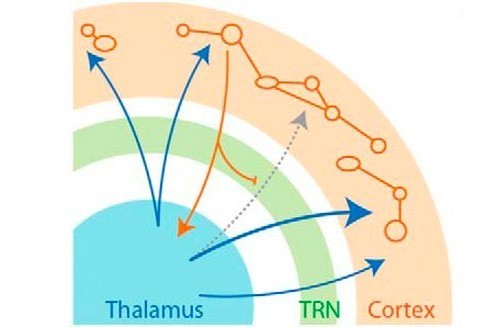
Mathieu Wolff & Seralynne Vann dans JNeurosci
Mathieu Wolff, Co-Leader Decision & Adaptation team, INCIA ; Seralynne Vann, School of Psychology, Cardiff University, UK.
Mathieu and Seralynne contributed a symposium together at the NeuroFrance meeting held in Bordeaux in 2017 and have shared an interest for the contribution of subcortical structures and thalamic nuclei in cognitive functions for more than a decade.
The Cognitive Thalamus as a gateway to mental representations. Mathieu Wolff and Seralynne D. Vann. Journal of Neuroscience 2 November 2018, 0479-18; DOI: https://doi.org/10.1523/JNEUROSCI.0479-18.2018
Historically, the thalamus has been viewed as little more than a relay, simply transferring information to key players of the cast, the cortex and hippocampus, without providing any unique functional contribution. In recent years, evidence from multiple laboratories researching different thalamic nuclei has contradicted this idea of the thalamus as a passive structure. Dated models of thalamic functions are being pushed aside, revealing a greater and far more complex contribution of the thalamus for cognition. In this Viewpoint, we show how recent data support novel views of thalamic functions that emphasize integrative roles in cognition, ranging from learning and memory to flexible adaption. We propose that these apparently separate cognitive functions may, in fact, be supported by a more general role in shaping mental representations. Several features of thalamocortical circuits are consistent with this suggested role and we highlight how divergent and convergent thalamocortical and corticothalamic pathways may complement each other to support these functions.

Furthermore, the role of the thalamus for subcortical integration is highlighted as a key mechanism for maintaining and updating representations. Thus, all these functional features of thalamocortical circuits (reciprocity of connections, convergence, divergence, integration) are proposed to act synergistically to achieve cognitively relevant mental events. The presence of thalamic pathology in a number of neurological conditions reinforces the need to better understand the role of this region in cognition. Thalamus research has entered a new era and virtually any brain region has a thalamic story to tell. We believe in the potential of uniting efforts in promoting a cognitive view of the thalamus, from sensory salience to adaptive cognition.
Mathieu Wolff – PhD CRCN CNRS, HDR (INCIA)
Mise à jour: 08/05/19
